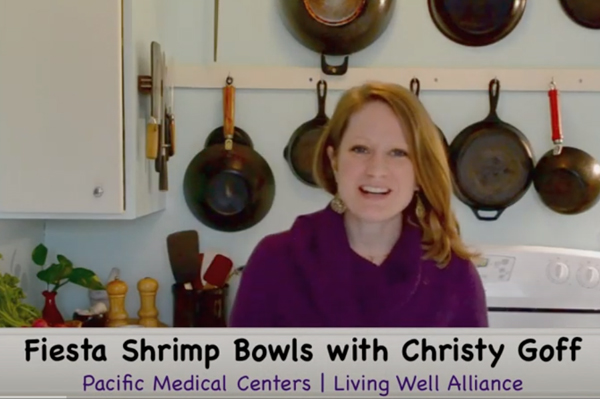LWA spotlight: Cooking video!
 The Living Well Alliance has an exciting, new cooking video to share! Watch Christy prepare a Fiesta Shrimp Grain Bowl—an easy meal for a busy weeknight. Stay tuned throughout the year as the LWA team shares different variations on this grain bowl.
The Living Well Alliance has an exciting, new cooking video to share! Watch Christy prepare a Fiesta Shrimp Grain Bowl—an easy meal for a busy weeknight. Stay tuned throughout the year as the LWA team shares different variations on this grain bowl.
Want to host a cooking demo at your office or apartment, or for an event? LWA can do this easily! Just pick a theme and reserve a conference room. We’ll do the rest. Email LWA for more information or to book your next LWA class.
The Living Well Alliance is run by Pacific Medical Centers. Call us today at 206.621.4419 for more information or email LivingWellAlliance@pacmed.org
Recipe: Parmesan Roasted Snap Peas
 This simple and tasty recipe is the perfect introduction to spring! Whether you grow your own peas or buy them at the store, roasted snap peas are a great side dish or healthy snack. They taste good hot or cold.
This simple and tasty recipe is the perfect introduction to spring! Whether you grow your own peas or buy them at the store, roasted snap peas are a great side dish or healthy snack. They taste good hot or cold.
Got a Crush on a Crash Diet?
 NUTRITION CORNER: Got a crush on a crash diet? Check the research
NUTRITION CORNER: Got a crush on a crash diet? Check the research
A new diet seems to hit the headlines every week: the Nordic! HMR! Alkaline! 5:2! The promises can sound great, but be sure to slow down and check with the experts. Your health is on the line! Let’s take a deeper look at what the research says about three diets that are hot today—especially since it’s March, National Nutrition Month.
Intermittent fasting
With intermittent fasting, you follow various patterns of fasting through the day or week. The three main patterns are alternate-day fasting (alternating a day with no food with a day of unrestricted eating), modified fasting (days of partial fasting, meaning 25% fewer calories on those days, and then other days with unrestricted eating) and time-restricted feeding (no eating between certain hours). Other names for this diet trend include the Fast Diet, 5:2 or 8/16 diet.
Research shows some promise, with rat and mice studies demonstrating weight loss while preserving lean muscle. However, more studies are needed in human populations for weight loss, as well as to determine how and if intermittent fasting differs in general from daily caloric restriction.
Should I try it? There are several valid concerns about this diet. For starters intermittent fasting was ranked 33 out of 41 by 2019 US News & World Report for 2019 Best Overall Diet. Second, be wary of long-term bouts of fasting to make sure you are meeting your nutrient requirements. Lastly, fasting is not recommended for those with diabetes or a history of eating disorders, pregnant or breastfeeding women, or if you have a health condition where medications are taken only with food.
Ketogenic diet
The ketogenic or keto (“KEY-toe”) diet is a calorie-restrictive program that mandates a high fat intake and a low carbohydrate intake to put the body in a state of ketosis. Ketosis occurs when your body does not have enough glucose (or sugars) available to fuel the brain and maintain cellular function, and so it starts to break down fatty acids into ketones. Maintaining a state of ketosis requires you to eat no more than 20-50g of carbohydrates per day, depending on your total calorie intake.
Research shows that like most calorie-restrictive diets, this one works temporarily. Studies also found that keto dieters have improved satiety (the sense of fullness) levels because of the high fat recommendations, and because the appetite-stimulating hormone is reduced during ketosis. Another study showed that those on the keto diet improved insulin sensitivity; however, it also noticed that they are more fatigued than their counterparts and that both their cholesterol (both LDL and HDL) and certain inflammatory markers increased. Additionally, there are risks for developing kidney stones, bone fractures and constipation because of micronutrient deficiencies and limited fiber intake. Often, it is recommended to supplement the keto diet with vitamins and minerals to get the proper amounts of nutrients in ketosis.
Should I try it? The keto diet was ranked 38 out of 41 by US News & World Reports, which demonstrates that it isn’t the most favorable eating plan for most. If you do try it, it’s important to work with a physician and dietitian to make sure you are meeting your micronutrient needs or managing any medication interactions. This diet plan can also be socially isolating due to its strict nature, so it is important to be on the watch for mental health effects.
Whole30 diet
The Whole30 diet is a popular eating plan to “reset” digestion and potentially provide some weight loss benefits. For 30 days, dieters follow a plan that promotes fresh foods while eliminating many processed options like salty snacks and desserts. It also eliminates dairy; grains; legumes; alcohol; additives like MSG, carrageenan or sulfites; and peanut butter—all for claims of better digestion, skin health, metabolism and overall sense of well-being. Snacking is frowned upon and exercise is promoted. At day 30, dieters reintroduce all foods slowly to determine how the body responds to each addition.
Should I try it? This diet comes with lots of promises but little research to back it up, so more study is needed. Whole30 is ranked 38 out of 41 in best overall diet, showing again the limited benefits for embarking on this journey. However, this plan does take people back to the kitchen to cook whole foods, which is helpful for consuming the recommended fruits and vegetables. If starting this plan, make sure to have a strong support system, good meal planning skills and the dedication to complete it.
Crash diets vs. healthy lifestyle changes
With any eating plan, it’s important to tell your health care team if you are dieting for longer than a month or two to ensure nutrient deficiencies are minimized and, in extreme cases, lab work is monitored. Diets rarely lead to long-term health or even weight loss, yet they often promote food restriction, are inflexible and almost seem a punishment for one’s weight and body size.
So, what works better? Aim for lifestyle changes that switch your mindset to eating for health not size. This approach includes supporting and acknowledging your relationship with food, being flexible with eating, and accepting and welcoming all foods that support our physical health and emotional health. We can all be healthy in our own way and time, especially with the individualized help of our health care team. Think long term!
Spring Cleaning for the Heart
 By Ameet Parikh, MD, Cardiologist at Pacific Medical Centers
By Ameet Parikh, MD, Cardiologist at Pacific Medical Centers
Spring’s glorious colors and sunshine often inspire us to get our lives in order—declutter, organize and clean. Suddenly, we can’t wait to tackle that patch of weeds or the bulging tool drawer in the kitchen! Why not take that same energy and refresh your heart-healthy habits? I encourage everyone to take control of their cardiac health.
Explore these four heart-healthy projects and make a “SMART” goal or two—Specific, Measurable, Achievable, Realistic and Time-bound.
Project 1: Eat healthier
Diet is a key factor to overall heart health. While it’s okay to indulge every now and then, the bulk of your meals should be made up of whole grains, fruits and vegetables. In general, you should minimize sodium, unhealthy saturated and trans fats, and refined grain products (such as white bread, pasta and pastries). To spring clean your diet, try swapping in oils made from olive, fish, avocado, nut and seeds, which are healthier monosaturated or polyunsaturated fats. Eat a freshly prepared meal at home, since restaurants tend to have a heavy hand with the saltshaker. Finally, control portion sizes by using a small plate or bowl. It will help you avoid the temptation to overeat.
Sample SMART goal:
“For two meals this week, I will replace white bread or pasta with whole-grain tortillas, brown rice or a yam.”
Project 2: Get regular exercise
The American Heart Association recommends a total of 150 minutes of exercise per week, including muscle-building activities like resistance or weight training at least two days per week. Let’s break this down into more realistic, achievable tasks. First, remember that any amount of exercise is better than none. If you spend most of your day sitting, set a timer a few times a day to remind yourself to get up and move. This can be as simple as a walk around the office, up and down the stairs, a sanity speed walk in the neighborhood, or even a few stretches on the floor.
Sample SMART goals:
“At every lunchtime this week, I will walk for 15 minutes before or after my meal.”
“By Thursday, I will contact my primary care provider for help crafting a suitable exercise routine.”
Project 3: Sleep more and better.
A lack of sleep can lead to a number of long-term health issues, including an increased risk of cardiovascular and coronary heart disease. It’s vital to try and achieve at least eight hours of sleep per night by establishing a sleep schedule. Also, avoiding caffeine and alcohol late in the day can help you get more hours at night.
Sample SMART goal:
“I will shut off all screens and do something quiet for 30 minutes before bedtime for the next week.”
Project 4: Stop smoking
Tobacco and nicotine in all forms is dangerous for overall cardiovascular health and should be avoided entirely. Even one cigarette a day can be detrimental to your health, as can e-cigarettes. The good news is that it’s never too late to stop, and your doctor can provide tips and resources to help you along the way.
Sample SMART goal:
“Before Friday, I will set up an appointment with my primary care provider to design a good tobacco-cessation plan for me.”
Get support for your heart-healthy life
Be sure to evaluate and reset your goal as needed. It’s also helpful to identify personal roadblocks—maybe lunchtime is your weakness, or a coworker is sabotaging your tobacco-free efforts.
Your medical team can give you vital information and support. Schedule a visit with your primary care provider or cardiologist to review your medical history, check your cholesterol and blood sugar levels, and determine your risk. I believe everyone can make healthy lifestyle changes that will help build a strong heart for years to come.
Be sure to evaluate and reset your goal as needed. It’s also helpful to identify personal roadblocks—maybe lunchtime is your weakness, or a coworker is sabotaging your tobacco-free efforts.
Your medical team can give you vital information and support. Schedule a visit with your primary care provider or cardiologist to review your medical history, check your cholesterol and blood sugar levels, and determine your risk. I believe everyone can make healthy lifestyle changes that will help build a strong heart for years to come.
Dr. Parikh is a Cardiologist at Pacific Medical Centers. Meet our full Cardiology team and learn about our primary care services.
Eat, Savor and Be Mindful
 Every April 22, communities around the world celebrate Earth Day, a focused time to honor our planet and renew efforts to safeguard its health. This year, on the forty-ninth Earth Day, we suggest combining mindfulness with eating as a path toward greater public health—supporting healthier families and communities, right here at home.
Every April 22, communities around the world celebrate Earth Day, a focused time to honor our planet and renew efforts to safeguard its health. This year, on the forty-ninth Earth Day, we suggest combining mindfulness with eating as a path toward greater public health—supporting healthier families and communities, right here at home.
If we think of the environment as everything in the world surrounding us, then it seems fair to say that the condition of our environment plays a pretty big role in our ability to live safe, healthy and satisfying lives. Our minds and physical health are deeply affected by the quality of our air, soil and water. The quality of our environment can speed or slow healing. And in turn, our dietary choices have an impact on the environment.
One small step we each can take to both value and preserve our natural resources is to cultivate mindfulness about how and what we eat. Jon Kabat-Zinn, who founded a center for mindfulness within the University of Massachusetts Medical School, defines mindfulness as, “paying attention in a particular way: on purpose, in the present moment and non-judgmentally.”
Mindfulness is a powerful concept. Like any change, it takes time to integrate it into your life. Learn more about the power of creating a mindfulness practice below.
With dining, eating mindfully means, on one level, the act of slowing down to savor each bite. When you eat mindfully, you are engaged in the present moment. Dining becomes a conscious and deliberate and enjoyable act. A mindful approach to the table also means eating because you are hungry and stopping because you are full. Some simple mindful eating habits include setting a place at the table, consciously choosing to eat slower and putting your mobile phone off and in another room. (For more ideas, explore Nutrition by Carrie, by Carrie Dennett, MPH, RDN, CD.)
On another level, mindful eating means paying attention to the environmental aspect of food. Consider where a food item came from and the impact of its transportation on the environment. How much energy did it take to process a food item? You might also take a thoughtful look at packaging: is there another product with less plastic or a simpler container?
In our busy lives, it can be easy to rush through a meal and move on to the activity. When you intentionally take time for a meal, focus on the ingredients and savor the flavors, you can also support and celebrate our wonderful planet.
How do I create a mindfulness practice?
A mindfulness practice can solidify a fleeting sense of contentment into a deeper sense of unity and presence. There are fabulous, sometimes-free resources available to help you develop a mindfulness practice. To learn more about the benefits of mindfulness, explore the 10% Happier podcast. The popular Headspace app at www.headspace.com offers guided meditations, practice on breath awareness and basic tips. The entry level is free. A good book to start with is Kabat-Zinn’s Mindfulness for Beginners. Sharon Salzburg offers a 28-day plan in her book Real Happiness.
How to Stay on Track: Prioritizing Health

PacMed dietitian discusses health and wellness in honor of National Nutrition Month
Now that March is in full swing, many may find themselves running on fumes of January’s resolutions, or perhaps the dedication to the “new year, new me” mantra has been abandoned entirely. Fortunately, Pacific Medical Centers’ Registered Dietitian Christy Goff, MS, RDN, CD, is on the scene to discuss food and nutrition, guiding the wayward health-centered ambitions back on track towards success and ultimate fulfillment.
Can you explain how the aspects of food, health, and fitness all relate to the concept of nutrition?
Nutrition can encompass many aspects of people’s health, including what they are eating, how they are moving, the amount of sleep they get and the amount of stress they are under. These factors can have a profound effect on one’s food choices, cravings and ability to make healthy choices. For example, there have been several studies indicating that those who consistently get less than six hours of sleep each night or who are chronically stressed tend to eat more calories and exercise less the next day. We cannot ignore these powerful connections between nutrition and other parts of our lifestyle.
There are so many fad diets out there. How can people determine what dieting strategies are appropriate for them as an individual?
Fad diets are extremely popular in our culture because they encourage fast weight loss and are seemingly quick fixes to health problems. However, most people who have been on a fad diet can tell you they have gained the weight back that was lost, or quit shortly after starting because of the restrictive nature. I do not recommend many diets due to their negative outcomes, possible nutrient deficiencies and short-term mindset. Instead, I encourage people to have realistic expectations about their health concern and to start small on their desired changes. Progress doesn’t always happen as fast as we want, but if we can turn our thinking into more long-term lifestyle changes rather than fad diets, we will be a lot healthier as a culture.
Is there a core set of guidelines you suggest most people follow in regards to nutrition?
Nutrition can seem really complicated because the media portrays a new message almost daily that either praises foods or demonizes them. Here are a core set of guidelines I continuously give to my clients and classes:
- Work to increase your fruits and vegetables to 5-7 servings daily. It has been proven that eating high amounts of fruits and vegetables can prevent chronic diseases such as heart disease and cancer, yet many of us fall short of this recommendation.
- Cook with more whole foods. This will almost always be healthier than buying something at a restaurant or in the frozen section, due to the huge reduction in sodium and filler items. By eating minimally processed foods, we are automatically increasing the amount of nutrient-rich foods we consume.
- Eat mindfully. We are a fast-paced culture that often eats quickly in many nontraditional places like a car, in front of the TV or at a work desk. By taking the time to breathe and pause between bites, it helps us feel less stressed and reminds our brain to stop eating when we feel full.
What piece of advice can you offer to busy military personnel who are looking to make improvements to their health but have a hectic work schedule?
Start small with your health goals. It is hard to change everything at once, so pick something on the top of your list that you value and outline some strategies to get started. It is also helpful to remember your barriers in completing the goal, so you can problem solve and make a plan before they occur. Some examples to focus on include reducing sodium, increasing healthy fats or adding more fiber. Remember small changes can result in a big impact down the line, especially if it becomes a regular habit.
Is there anything else you would like readers to know about nutrition?
Nutrition is a challenging field because recommendations frequently change. While the media may put a dramatic spin on studies, know that these conclusions aren’t always fact. My advice is to be careful of what you read on the Internet, or even in a book about nutrition, and make sure you know the source. If you need information, it’s best to look for articles and books that are written by a registered dietitian or, book an appointment to get more personalized care.
Christy Goff is a registered dietitian with the PacMed Living Well Alliance team. Learn more about the Living Well Alliance








